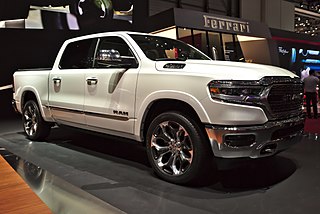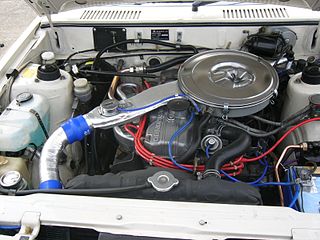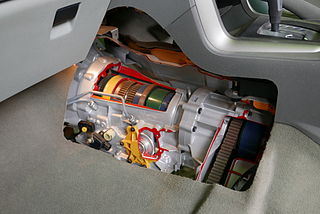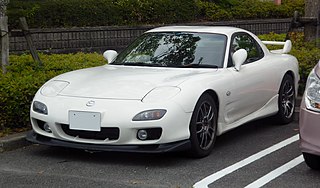
The K-car platform was a key automotive design platform introduced by Chrysler Corporation in 1981, featuring a transverse engine, front-wheel drive, independent front and semi-independent rear suspension configuration—a stark departure from the company's previous reliance on solid axle, rear-drive configurations. Derived from Chrysler's L-cars, the Plymouth Horizon and Dodge Omni, the platform was developed just as the company faltered in the market, at first underpinning a modest range of compact/mid-size sedans and wagons—and eventually underpinning nearly fifty different models, including all-wheel drive variants—and playing a vital role in the company's subsequent resurgence.

The Ram pickup is a full-size pickup truck manufactured by FCA US LLC and marketed as of 2011 onwards under the Ram Trucks brand. The current fifth-generation Ram debuted at the 2018 North American International Auto Show in Detroit, Michigan in January of that year.

The CA engine is a 1.6 to 2.0 L Inline-4 piston engine from Nissan designed for a variety of smaller Nissan vehicles to replace the Z engine and some smaller, four-cylinder L series engines. It is an iron block, aluminum head design with a timing belt, cheaper to make than the timing chain setup on the Z and L engines. Earlier versions featured SOHC and eight valves. The new CA block design was a scaled-up E series block with timing shaft and other ancillaries removed. The oil pump is fitted directly onto the crank nose and the distributor is driven by the end of the camshaft. Like the E series and the A block from which the E was derived, Nissan used a taller block for the largest stroked 2.0-litre engine. The CA was designed to be compact and light, with a CA16 requiring only 195 litres of space, while weighing 23% less at 115 kg (254 lb). The engine was called the "CA" series for Clean Air, due to the installation of Nissan emission reducing technology, called NAPS-X.

The Jeep Comanche is a pickup truck variant of the Cherokee compact SUV (1984–2001) manufactured and marketed by Jeep for model years 1986-1992 in rear wheel (RWD) and four-wheel drive (4WD) models as well as two cargo bed lengths: six-foot and seven-foot.

The Motor Trend Car of the Year (COTY) is an annual award given by Motor Trend magazine to recognize the best new or significantly refreshed car in a given model year.

The Mitsubishi Astron or 4G5/4D5 engine, is a series of straight-four internal combustion engines first built by Mitsubishi Motors in 1972. Engine displacement ranged from 1.8 to 2.6 litres, making it one of the largest four-cylinder engines of its time. It became the first Japanese production engine to combine both electronic fuel injection (EFI) and turbocharging.

TorqueFlite is the trademarked name of Chrysler Corporation's automatic transmissions, starting with the three-speed unit introduced late in the 1956 model year as a successor to Chrysler's two-speed PowerFlite. In the 1990s, the TorqueFlite name was dropped in favor of alphanumeric designations, although the latest ZF-based transmissions with the 8-speed automatic has revived the name.

The Nissan Z engine is a series of automobile and light truck engines that was engineered by Nissan Machinery, manufactured by the Nissan Motor Company from 1979 through August 1989. All Z engines had 4 cylinders, a total of 8 valves and a single overhead camshaft (SOHC). Displacements ranged from 1.6 L to 2.4 L.The Z series' engine blocks were nearly identical to those of the earlier L Series with the exception of the Z24. While the Z16 and Z18 engines had a deck height similar to the earlier L13/L14/L16/L18 variants, the Z24 had a taller deck height to accommodate a longer stroke. The most notable difference between the Z-series engine and its predecessor was the introduction of a new crossflow cylinder head which reduced emissions by moving the intake ports to the right side of the engine opposite the exhaust ports. This change allows the exhaust port velocity to more effectively scavenge the cylinder and reduce reversion pulses to enhance induction. The Z series evolved into the NA and KA engines which, along with the smaller CA series, replaced the Z series.
The Ford C3 transmission and its descendants are a family of light-duty longitudinal automatic transmissions built by the Ford Motor Company.
The Jatco 3N71 transmission was the first 3-speed automatic transmission from Nissan. It was an introduced as a conventional alternative to the then-ubiquitous and popular Borg-Warner Type 35. It was designed for use with rear wheel drive vehicles with longitudinal engines. In 1982, it gained a locking torque converter (L3N71b) for greater efficiency, and gained an overdrive section in 1983 (L4N71b), culminating with preliminary electronic sensors and control functions being added in 1985 (E4N71b).
The 4R01 was a 4-speed automatic transmission from Nissan's Jatco subsidiary. It was available as either a light-duty ("RL4R01A") or medium-duty ("RE4R01A") unit for rear wheel drive vehicles with longitudinal engines. Mazda called the medium-duty version their R4A-EL.

Hidden headlamps, also commonly known as pop-up headlamps, hideaway headlights, are a form of automotive lighting and an automotive styling feature that conceals an automobile's headlamps when they are not in use.

The Nissan Silvia is the name given to the company's long-running line of sport coupes based on the Nissan S platform. Although recent models have shared this chassis with other vehicles produced by Nissan, the name Silvia is interchangeable with the chassis codes. The Nissan Silvia's main competitors worldwide were the Honda Prelude, Mazda MX-6, Toyota Celica, Mitsubishi Eclipse, Isuzu Impulse, Toyota Corolla, Subaru Impreza, and Honda Integra.




















